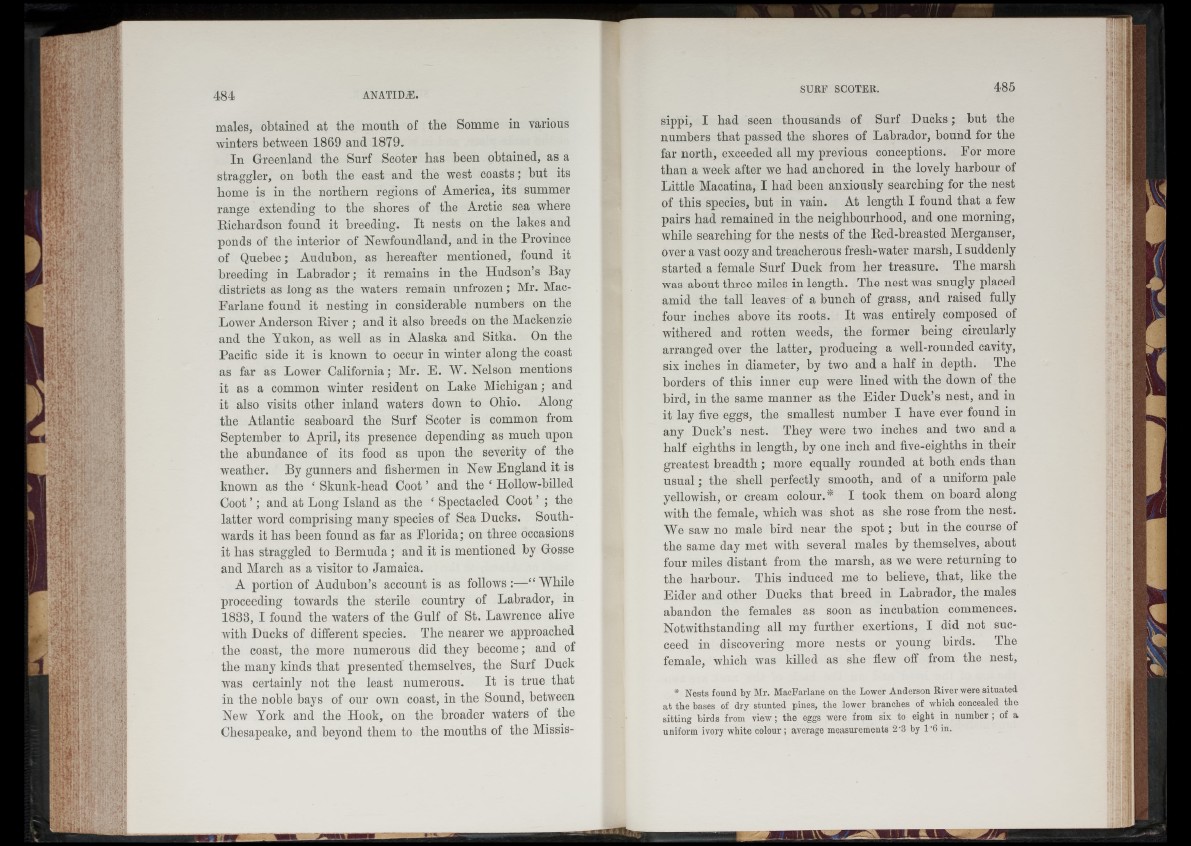
males, obtained at tlie month of the Somme in various
winters between 1869 and 1879.
In Greenland the Surf Scoter has been obtained, as a
straggler, on both the east and the west coasts; but its
home is in the northern regions of America, its summer
range extending to the shores of the Arctic sea where
Richardson found it breeding. It nests on the lakes and
ponds of the interior of Newfoundland, and in the Province
of Quebec; Audubon, as hereafter mentioned, found it
breeding in Labrador; it remains in the Hudson’s Bay
districts as long as the waters remain unfrozen; Mr. Mac-
Farlaue found it nesting in considerable numbers on the
Lower Anderson River ; and it also breeds on the Mackenzie
and the Yukon, as well as in Alaska and Sitka. On the
Pacific side it is known to occur in winter along the coast
as far as Lower California; Mr. E. W. Nelson mentions
it as a common winter resident on Lake Michigan; and
it also visits other inland waters down to Ohio. Along
the Atlantic seaboard the Surf Scoter is common from
September to April, its presence depending as much upon
the abundance of its food as upon the severity of the
weather. By gunners and fishermen in New England it is
known as the ‘ Skunk-head Coot ’ and the ‘ Hollow-billed
Coot ’; and at Long Island as the ‘ Spectacled Coot ’ ; the
latter word comprising many species of Sea Ducks. Southwards
it has been found as far as Florida; on three occasions
it has straggled to Bermuda ; and it is mentioned by Gosse
and March as a visitor to Jamaica.
A portion of Audubon’s account is as follows:—“ While
proceeding towards the sterile country of Labrador, in
1833, I found the waters of the Gulf of St. Lawrence alive
with Ducks of different species. The nearer we approached
the coast, the more numerous did they become; and of
the many kinds that presented themselves, the Surf Duck
was certainly not the least numerous. It is true that
in the noble bays of our own coast, in the Sound, between
New York and the Hook, on the broader waters of the
Chesapeake, and beyond them to the mouths of the Mississippi,
I had seen thousands of Surf Ducks; but the
numbers that passed the shores of Labrador, bound for the
far north, exceeded all my previous conceptions. For more
than a week after we had anchored in the lovely harbour of
Little Macatina, I had been anxiously searching for the nest
of this species, but in vain. At length I found that a few
pairs had remained in the neighbourhood, and one morning,
while searching for the nests of the Red-breasted Merganser,
over a vast oozy and treacherous fresli-water marsh, I suddenly
started a female Surf Duck from her treasure. The marsh
was about three miles in length. The nest was snugly placed
amid the tall leaves of a bunch of grass, and raised fully
four inches above its roots. It was entirely composed of
withered and rotten weeds, the former being circularly
arranged over the latter, producing a well-rounded cavity,
six inches in diameter, by two and a half in depth. The
borders of this inner cup were lined with the down of the
bird, in the same manner as the Eider Duck’s nest, and in
it lay five eggs, the smallest number I have ever found in
any Duck’s nest. They were two inches and two and a
half eighths in length, by one inch and five-eighths in their
greatest breadth ; more equally rounded at both ends than
usual; the shell perfectly smooth, and of a uniform pale
yellowish, or cream colour.'1' I took them on board along
with the female, which was shot as she rose from the nest.
We saw no male bird near the spot; but in the course of
the same day met with several males by themselves, about
four miles distant from the marsh, as we were returning to
the harbour. This induced me to believe, that, like the
Eider and other Ducks that breed in Labrador, the males
abandon the females as soon as incubation commences.
Notwithstanding all my further exertions, I did not succeed
in discovering more nests or young birds. The
female, which was killed as she flew off from the nest,
* Nests found by Mr. MacFarlane on the Lower Anderson River were situated
at the bases of dry stunted pines, the lower branches of which concealed the
sitting birds from view; the eggs were from six to eight in number ; of a
uniform ivory white colour ; average measurements 2 ‘3 by l ’C in.